![]()
![]()
![]()
Use LEFT and RIGHT arrow keys to navigate between flashcards;
Use UP and DOWN arrow keys to flip the card;
H to show hint;
A reads text to speech;
82 Cards in this Set
- Front
- Back
|
Ecology |
The study of organisms with their environments, including biotic and abiotic factors |
|
|
Biotic factors |
Living factors E.g. predation, competition, food availability |
|
|
Abiotic factors |
Non-living factors E.g. rainfall, soil pH, temperature, light intensity |
|
|
Ecosystems |
Ecological units consisting of several habitats and their associated communities with biotic and abiotic components |
|
|
Properties of ecosystems |
Stable, self-perpetuating systems Dynamic and so are subject to change |
|
|
Ways in which an ecosystem may change |
In energy flow In biological cycles In succession In species composition In population sizes |
|
|
Population |
A group of interbreeding individuals of the same species, occupying a particular place at a given time |
|
|
Community |
Consists of all organisms living in a particular habitat |
|
|
Habitat |
An area of an environment where an organism lives, feeds and breeds |
|
|
Niche |
Refers to the way in which an organism fits into an ecological community or ecosytem |
|
|
Population size |
The number in a population (is influenced by biotic and abiotic factors) |
|
|
Population density |
The numbers in a population per unit area |
|
|
What shape is population growth? |
Exponential |
|
|
What causes fluctuations in population growth? |
Birth rate / Rate of division or multiplication Death rate Emigration Immigration |
|
|
Emigration |
Non-reversible movement out of a population - can be triggered by overcrowding (don't confuse with seasonal migration) |
|
|
Immigration |
Movement into a population |
|
|
What happens if conditions are favourable for population growth? |
Birth + Immigration > Death + Emigration |
|
|
Biotic factors increasing population |
High birth rate Adequate food Ability to compete for resources Ability to defend against predators Resistance to disease or parasites |
|
|
Abiotic factors that increase population |
Favourable light Favourable temperature Optimum level of nutrients and minerals |
|
|
Shape of population curve in ideal conditions |
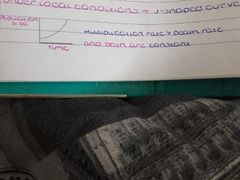
J-shaped |
|
|
Population crash cause |
Density independent event e.g. seasonal change / weather event / use of insecticides |
|
|
Population crash curve |
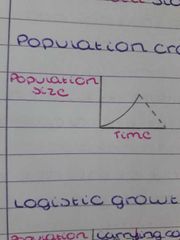
|
|
|
Logistic population growth curve |
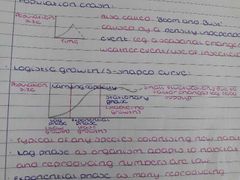
S-shaped curve |
|
|
Lag phase |
Organism is adapting to habitat and reproducing numbers are low |
|
|
Exponential phase |
Many reproducing individuals with little environmental resistance |
|
|
Stationary phase |
Birth rate = Death rate Population growth is limited and has reached the carrying capacity |
|
|
Carrying capacity (set point) |
The maximum population size that can be supported indefinitely by a given environment |
|
|
What causes a decline in population size? |
When one factor becomes in short supply |
|
|
What extra phase does bacterial growth have? |
Death phase which is caused by a depletion of nutrients or the build up of toxins |
|
|
Why is the exponential phase of bacteria steeper than that of sexually-reproducing organisms? |
Can reproduce sexually and asexually |
|
|
What causes fluctuations around the set point? |
Intraspecific competition |
|
|
Factors that cause environmental resistance |
Availability of food Parasitism Predation Disease Overcrowding Competition Weather Accumulation of toxic waste |
|
|
Comparison of ideal conditions and environmental resistance |
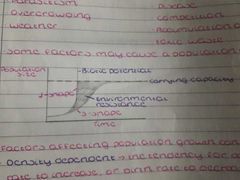
|
|
|
Density dependent factors |
The tendency for death rate to increase (or birth rate to decrease) as the population densirt increases |
|
|
Examples of density dependent factors |
Intraspecific competition Accumulation of toxins Disease Predation |
|
|
Density independent factors |
The tendency for the birth/growth/death rate to neither rise nor fall as the density increases (organisms are affected irrespective of density) Are always abiotic factors |
|
|
Examples of density independent factors |
Freezing temperatures Flooding Fires |
|
|
Limiting factors |
The factors that determine the carrying capacity of an environment for a species (density independent and dependent factors) |
|
|
Mortality rates curve |
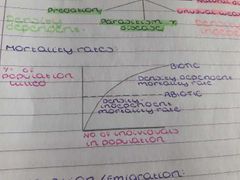
|
|
|
Population>Set point |
Density-dependent factor causes an increase in mortality or reduces breeding |
|
|
Set point>Population |
Environmental resistance temporarily relived so population increases |
|
|
Sampling techniques |
Random quadrants in an area where abiotic factors are the same Transects in an area with changing environmental factors Line transect (record what touches the tape at regular intervals) Belt transect (use quadrants at regular intervals along tape) Interrupted belt transect Continuous belt transect |
|
|
ACFOR Scale |
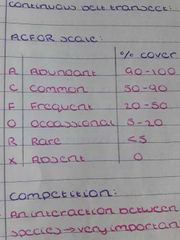
|
|
|
Competition |
An interaction between two or more organisms or species |
|
|
Intraspecific competition |
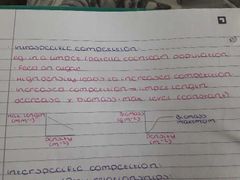
Individuals of the same species competing for the same resources |
|
|
Interspecific competition |
Between individuals of different species (e.g. predator/prey relationships) |
|
|
Predator/Prey relationships |
Species between two different trophic levels interact - population sizes affect each other |
|
|
Properties of a predator |
Usually larger in physical size and have a smaller population size than prey |
|
|
Short-lived seasonal predator/prey relationships |
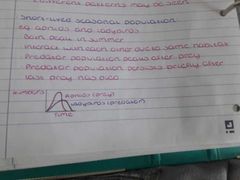
|
|
|
Long-lived predator/prey relationships |
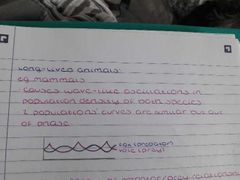
|
|
|
Effect of predator/prey relationships |
Immediate effects are beneficial to predator and harmful to prey BUT allows natural selection of prey due to periodic population crash |
|
|
Gause's Law of Competitive Exclusion |
States that two species competing for the exact same species can not stably coexist as one competitor will have an advantage which leads to (near) extinction of the other (Explains evolutionary shift) |
|
|
Example of Competitive Exclusion Principle |
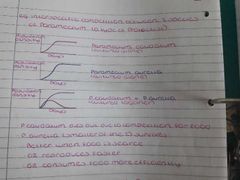
|
|
|
Trophic structure |
Represents the different feeding relationships that determine the route of energy flow and the pattern of chemical cycling |
|
|
Producers |
Create energy by photosynthesis or chemosynthesis at the start of food chains |
|
|
Decomposers |
E.g. bacteria / fungi |
|
|
Detritivores |
Eat decaying matter e.g. bacteria, fungi, woodlice, worms |
|
|
Food chains |
Show feeding relationships between organisms in an ecosystem |
|
|
How many steps are there in tropical water food chains? |
5 - 7 steps (larger than other) |
|
|
Food web |
A more complex diagram to show interrelated food chains in an ecosystem |
|
|
How much of the energy is consumed is converted into biomass for the next level in pyramids of biomass? |
10% |
|
|
Biomass |
The mass of living material in an ecosystem (measured by dry weight per unit area of land / per volume of water) |
|
|
Gross Primary Productivity (GPP) |
The rate of production of chemical energy in organic molecules by photosynthesis (in kJ m-2 year-1) |
|
|
Net Primary Productivity (NPP) |
The potential energy available to primary consumers (GPP minus the chemical energy generated in respiration and used by the producer's metabolism in the year) |
|
|
NPP Formula |
NPP = GPP - R |
|
|
Factors that limit NPP (cause biomass to accumulate slowly) |
Low rainfall Low temperatures Few available nutrients A short growing season |
|
|
NPP:GPP ratio for larger producers |
Is smaller than that for smaller producers as they support large metabolically active root and stem systems |
|
|
How to compare productivity of different ecosystems? |
Use NPP values |
|
|
Photosynthetic efficency |
The fate of solar energy falling on a leaf |
|
|
Photosynthetic efficiency formula |
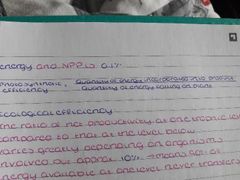
|
|
|
Ecological efficiency |
The ratio of net productivity at one trophic level compared to that of the level below |
|
|
Usual ecological efficiency value |
Approx. 10% |
|
|
Gross ecological efficiency of herbivores |
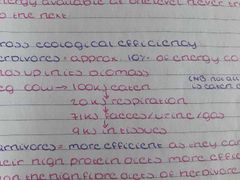
Approx. 10% |
|
|
Why are carnivores more efficient than herbivores? |
They can digest their high protein diets more efficiently than the high fibre diets of herbivores |
|
|
Succession |
The change in structure and species composition of a community over time |
|
|
Seral stages / Seres |
Different stages of succession when particular species dominate |
|
|
Climax community |
The most stable and biologically diverse community in succession |
|
|
Primary succession |
Begins with no organic matter (just sand, bare rock, etc) Colonisation by pioneer communities (e.g. algae, lichens) Increased weathering of rock by sand, grit, etc. Death of organisms (provides organic matter) Small plants in thin soil grow (e.g. missed, ferns) - annual plants Death and decomposition of annuals provides thicker soil Growth of flowering plants - perennial plants Natural climax community (E.g. deciduous oak woodland in the UK) |
|
|
Secondary succession |
Organic matter in area due it previously supporting life Bare earth due to fire / volcanic activity / flooding Plants grow from spores / seed / corms / bulbs of previous plants that colonised area (no pioneer species) |
|
|
Factors affecting succession |
Adjacent areas Spores / seeds being carried by the wind to the area Immigration / Emigration |
|
|
Facilitation |
Species interactions that benefit at least one of the species but with no harm to any of the species (e.g. increased resources, protection) |
|
|
What occurs as succession progresses? |
Increase in biomass Increase is biodiversity |

